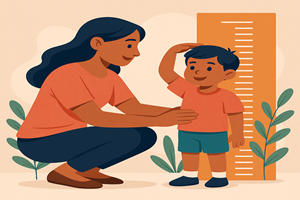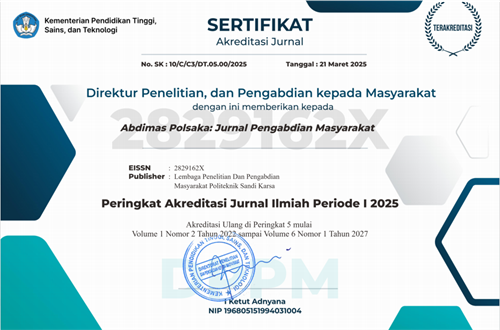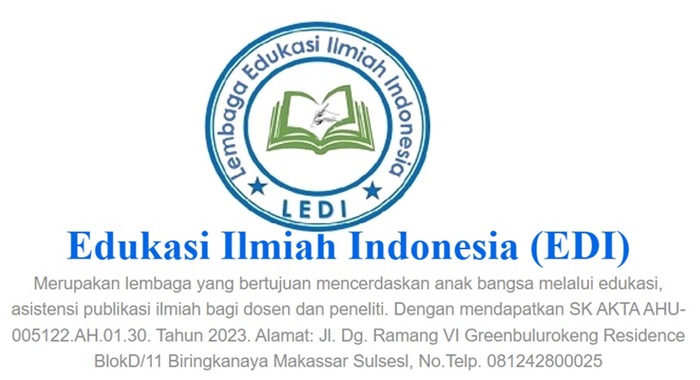Importance of the role of mothers in stunting prevention efforts
DOI:
https://doi.org/10.35816/abdimaspolsaka.v4i2.108Keywords:
Balanced Nutrition, Breastfeeding, Mothers’ Role, Public Health Education, Stunting PreventionAbstract
Stunting is a growth and developmental disorder in children caused primarily by chronic malnutrition and inadequate access to essential nutrients during critical early childhood. Mothers with adequate nutritional knowledge tend to prioritise their children’s dietary needs, enabling optimal growth and development. Preventing stunting is vital due to its long-term impacts on physical, cognitive, and economic potential. This community service activity aimed to enhance mothers' and families' knowledge, awareness, and skills in stunting prevention from an early stage. The program involved 20 women of reproductive age in the working area of Pattingalloang Health Center, Makassar. Activities included health education through socialization, discussions, and distribution of leaflets covering definitions, causes, prevention, and management of stunting. Interactive counseling sessions emphasized the importance of the First 1,000 Days of Life, balanced nutrition, exclusive breastfeeding, and appropriate complementary feeding practices. The high participation and engagement rates reflected increased enthusiasm and awareness regarding stunting, an issue often underestimated in the community. Key supporting factors included active participation, health worker collaboration, and adequate facilities, while limiting factors involved time constraints and fewer participants than targeted. The program significantly improved mothers’ understanding of their crucial role in stunting prevention and demonstrated that community-based, participatory interventions effectively support national stunting reduction goals.
Downloads
References
N. Adam, J. Fitrianingsih, and M. Basir, “The role of knowledge in improving attitudes and behaviors of stunting prevention in pregnant women,” J. Ilm. Kesehat. Sandi Husada, vol. 13, no. 2, pp. 403–410, Dec. 2024, doi: https://doi.org/10.35816/jiskh.v13i2.1230.
H. Ashar et al., “A qualitative study in Magelang Central Java Indonesia: Mothers’ knowledge, parenting styles and national priority programs managing of stunting in toddlers,” Soc. Sci. Humanit. Open, vol. 12, p. 101874, 2025, doi: https://doi.org/10.1016/j.ssaho.2025.101874.
R. Ayu Rahmadani, A. Setiawati, I. Aris, A. Lontaan, and P. Prasetyowati, “Effectiveness of nutrition education on stunting prevention behavior in mothers under five,” J. Edukasi Ilm. Kesehat., vol. 3, no. 1, pp. 01–08, Mar. 2025, doi: https://doi.org/10.61099/junedik.v3i1.68.
S. Baulia, “Is household shock a boon or bane to the utilisation of preventive healthcare for children? Evidence from Uganda,” Econ. Hum. Biol., vol. 52, p. 101333, 2024, doi: https://doi.org/10.1016/j.ehb.2023.101333.
D. Durevall and A.-S. Isaksson, “Aid and child health: A disaggregated analysis of the effects of aid on impaired growth,” World Dev., vol. 182, p. 106689, Oct. 2024, doi: https://dx.doi.org/10.1016/j.worlddev.2024.106689.
K. A. Erika et al., “Stunting Super App as an Effort Toward Stunting Management in Indonesia: Delphi and Pilot Study,” JMIR Hum. Factors, vol. 11, pp. e54862–e54862, Dec. 2024, doi: https://dx.doi.org/10.2196/54862.
M. O. Feiler, E. R. Kulick, K. Sinclair, N. Spiegel, S. Habel, and O. G. Castello, “Toxic metals and pediatric clinical immune dysfunction: A systematic review of the epidemiological evidence,” Sci. Total Environ., vol. 927, p. 172303, 2024, doi: https://doi.org/10.1016/j.scitotenv.2024.172303.
L. A. Garina et al., “Maternal, Child, and Household Risk Factors for Children with Stunting,” Open Public Health J., vol. 17, no. 1, Sep. 2024, doi: https://dx.doi.org/10.2174/0118749445321448240823112908.
G. Gunasekaran, D. K. Thirugnanam, A. Balasubramaniam, N. N. Jayanthi, and K. V Leela, “Acute Respiratory Tract Infections in Pediatric Populations of Slum Areas: Navigating Challenges and Dynamics of Immune Responses,” Curr. Pediatr. Rev., vol. 21, no. 3, pp. 245–267, 2025, doi: https://doi.org/10.2174/0115733963309043240703115735.
M. P. Herrero Jiménez, S. del Pozo de la Calle, C. Cuadrado Vives, and D. Escobar Sáez, “Nutritional supplementation in pregnant, lactating women and young children following a plant-based diet: A narrative review of the evidence,” Nutrition, vol. 136, p. 112778, 2025, doi: https://doi.org/10.1016/j.nut.2025.112778.
J. S. Kshatri et al., “A comprehensive assessment of health indicators among tribal populations in Odisha, India (Odisha Tribal Family Health Survey): a community-based, cross-sectional study,” Lancet Reg. Heal. - Southeast Asia, vol. 38, p. 100611, 2025, doi: https://doi.org/10.1016/j.lansea.2025.100611.
C. Madziva, M. J. Chinouya, and K. Njoroge, “Experiences of geophagy during pregnancy among African migrant women in London: Implications for public health interventions,” SSM - Qual. Res. Heal., vol. 5, p. 100431, 2024, doi: https://doi.org/10.1016/j.ssmqr.2024.100431.
R. Millati, A. Setyawati, I. Aris Tyarini, and I. Daiyah, “Capacity building of posyandu cadres through education and training in stunting prevention,” Abdimas Polsaka, vol. 4, no. 1, pp. 08–14, Mar. 2025, doi: https://doi.org/10.35816/abdimaspolsaka.v4i1.84.
N. Muna, S. Misba, T. Taamu, and N. Nurfatima, “The Relationship between Processed Food Consumption and Animal Protein Intake with the Incidence of Stunting in Toddlers,” J. Ilm. Kesehat. Sandi Husada, vol. 12, no. 2 SE-Book Review, Dec. 2023, doi: https://doi.org/10.35816/jiskh.v12i2.1172.
N. Nordianiwati, N. Gilang Fitriana, L. Situmean, I. Aris Tyarini, and A. Setyawati, “Education on the role of family in stunting prevention in toddlers,” Abdimas Polsaka, vol. 3, no. 1, pp. 14–19, Jan. 2024, doi: https://doi.org/10.35816/abdimaspolsaka.v3i1.62.
M. M. Pasqualino et al., “Complementary Food Supplements Fill Energy and Protein Gaps among Children with Dietary Inadequacy in a Complementary Feeding Trial in Rural Bangladesh,” J. Nutr., vol. 155, no. 2, pp. 602–611, 2025, doi: https://doi.org/10.1016/j.tjnut.2024.12.001.
M. J. Nyarko, W. ten Ham-Baloyi, and D. (R. M. . van Rooyen, “Qualitative Exploration of Health Professionals’ Perceptions of Addressing Malnutrition Within the First 1,000 Days,” J. Nutr. Educ. Behav., vol. 56, no. 7, pp. 442–451, Jul. 2024, doi: https://dx.doi.org/10.1016/j.jneb.2024.03.010.
G. V Proaño et al., “Effectiveness, barriers, and facilitators of overweight and obesity prevention strategies in Latin America; a scoping review and qualitative study in Colombia,” Lancet Reg. Heal. - Am., vol. 29, p. 100656, 2024, doi: https://doi.org/10.1016/j.lana.2023.100656.
G. Rezaeizadeh et al., “Maternal education and its influence on child growth and nutritional status during the first two years of life: a systematic review and meta-analysis,” eClinicalMedicine, vol. 71, p. 102574, May 2024, doi: https://doi.org/10.1016/j.eclinm.2024.102574.
P. M. Sawadogo, N. H. Ugwu, M. Phiri, and C. Arnaldo, “Prevalence and Factors Associated with Chronic Energy Deficiency among Adolescent Girls and Young Mothers in Sub-Saharan Africa,” Open Public Health J., vol. 17, 2024, doi: https://doi.org/10.2174/0118749445360112241205070152.
R. Sentika et al., “Expert Consensus on Interprofessional Collaboration (IPC) Guidelines on Stunting Management in Indonesian Primary Healthcare (Puskesmas),” Open Public Health J., vol. 17, no. 1, Dec. 2024, doi: https://doi.org/10.2174/0118749445352608241119164446.
S. D. Shanthi, “Impact of integrated child development scheme on nutritional and health status of children,” Child. Youth Serv. Rev., vol. 163, p. 107792, Aug. 2024, doi: https://doi.org/10.1016/j.childyouth.2024.107792.
M. Siddiqa, A. Zubair, A. Kamal, M. Ijaz, and S. M. A. Aljeddani, “Risk factors of child malnutrition under 5 years: Evidence from Pakistan using the Composite Index of Anthropometric Failure,” Nutrition, vol. 127, p. 112523, Nov. 2024, doi: https://doi.org/10.1016/j.nut.2024.112523.
I. A. Tyarini, A. Setiawati, R. Rahagia, and Y. Maidelwita, “Community empowerment in stunting prevention and control to build a healthy and productive generation,” J. Pengabdi. Masy. Edukasi Indones., vol. 1, no. 3, pp. 100–106, Sep. 2024, doi: https://doi.org/10.61099/jpmei.v1i3.56.
S. Suprapto, “Pengaruh Edukasi Media Kartun Terhadap Peningkatan Pengetahuan Ibu dan Status Gizi Anak,” J. Heal., vol. 9, no. 2, pp. 81–87, Jul. 2022, doi: https://dx.doi.org/10.30590/joh.v9n2.500.

Additional Files
Published
How to Cite
Issue
Section
License
Copyright (c) 2025 Irnawati Irnawati, Uliarta Marbun, Hasnita Hasnita

This work is licensed under a Creative Commons Attribution 4.0 International License.
Most read articles by the same author(s)
- Uliarta Marbun, Irnawati Irnawati, Edukasi Bahaya dan Pencegahan Preeklampsia Pada Kehamilan , Abdimas Polsaka: Vol. 2 No. 1 (2023): Abdimas Polsaka: Jurnal Pengabdian Masyarakat
- Irnawati Irnawati, Uliarta Marbun, Edukasi Keluarga dalam Penentuan Penerapan Posisi Persalinan yang Menguntungkan Pada Ibu Bersalin , Abdimas Polsaka: Vol. 1 No. 2 (2022): Abdimas Polsaka: Jurnal Pengabdian Masyarakat
- Hasnita Hasnita, Pencegahan dan Deteksi Dini Stunting Pada Balita , Abdimas Polsaka: Vol. 1 No. 2 (2022): Abdimas Polsaka: Jurnal Pengabdian Masyarakat
- Uliarta Marbun, Irnawati Irnawati, Psychological Readiness Education and Preparation Before Childbirth , Abdimas Polsaka: Vol. 2 No. 2 (2023): Abdimas Polsaka: Jurnal Pengabdian Masyarakat
- Uliarta Marbun, Irnawati Irnawati, Hasnita Hasnita, Empowering couples of childbearing age to become active family planning acceptors to create quality families , Abdimas Polsaka: Vol. 4 No. 2 (2025): Abdimas Polsaka: Jurnal Pengabdian Masyarakat
- Hasnita Hasnita, Uliarta Marbun, Irnawati Irnawati, Socialization of making moringa pudding to increase HB levels for pregnant women with anemia , Abdimas Polsaka: Vol. 4 No. 2 (2025): Abdimas Polsaka: Jurnal Pengabdian Masyarakat




















